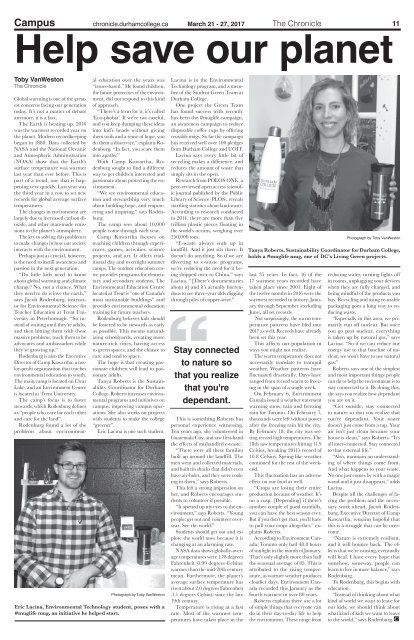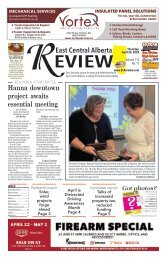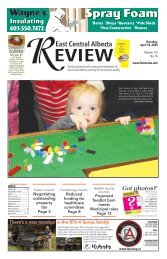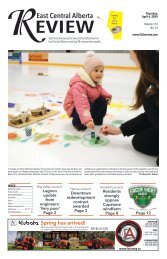Create successful ePaper yourself
Turn your PDF publications into a flip-book with our unique Google optimized e-Paper software.
Campus chronicle.durhamcollege.ca March 21 - 27, 2017 The Chronicle 11<br />
Help save our planet<br />
Toby VanWeston<br />
The Chronicle<br />
Global warming is one of the greatest<br />
concerns facing our generation<br />
today. It’s not a matter of debate<br />
anymore, it is a fact.<br />
The Earth is heating up. 20<strong>16</strong><br />
was the warmest recorded year on<br />
the planet. Modern recordkeeping<br />
began in 1880. Data collected by<br />
NASA and the National Oceanic<br />
and Atmospheric Administration<br />
(NOAA) show that the Earth’s<br />
surface temperature was warmer<br />
last year than ever before. This is<br />
part of a trend, one that is happening<br />
very quickly. Last year was<br />
the third year in a row to set new<br />
records for global average surface<br />
temperatures.<br />
The changes in environment are<br />
largely due to increased carbon dioxide,<br />
and other man-made emissions<br />
to the planet’s atmosphere.<br />
The key to solving this problem is<br />
to make changes in how our society<br />
interacts with the environment.<br />
Perhaps just as crucial, however,<br />
is the need to instill awareness and<br />
passion in the next generation.<br />
“Do little kids need to know<br />
about global warming and climate<br />
change? No, not a chance. What<br />
they need to do is love the earth,”<br />
says Jacob Rodenburg, instructor<br />
for Environmental Science for<br />
Teacher Education at Trent University<br />
in Peterborough. “So instead<br />
of waiting until they’re adults,<br />
and then hitting them with these<br />
massive problems, teach them to be<br />
advocates and ambassadors while<br />
they’re growing up.”<br />
Rodenburg is also the Executive<br />
Director of Camp Kawartha, a notfor-profit<br />
organization that teaches<br />
environmental education to youth.<br />
The main camp is located on Clear<br />
Lake, and an Environment Centre<br />
is located at Trent University.<br />
The camp’s focus is to foster<br />
stewards, which Rodenburg defines<br />
as “people who care for each other<br />
and care for the land”.<br />
Rodenburg found a lot of the<br />
problems about environmental<br />
education over the years was<br />
“issues-based.” He found children,<br />
the future protectors of the environment,<br />
did not respond to this kind<br />
of approach.<br />
“There’s a term for it, it’s called<br />
‘Eco-phobia’. If we’re not careful,<br />
and you keep dumping these ideas<br />
into kid’s heads without giving<br />
them tools and a sense of hope, you<br />
do them a disservice,” explains Rodenburg.<br />
“In fact, you scare them<br />
into apathy.”<br />
With Camp Kawartha, Rodenburg<br />
sought to find a different<br />
way to get children interested and<br />
passionate about protecting the environment.<br />
“We see environmental education<br />
and stewardship very much<br />
about building hope, and empowering<br />
and inspiring,” says Rodenburg.<br />
The camp sees about 10,000<br />
people come through each year.<br />
Camp Kawartha focuses on<br />
teaching children through experiences,<br />
games, activities, science<br />
projects, and art. It offers traditional<br />
day and overnight summer<br />
camps. The outdoor education centre<br />
provides programs for elementary<br />
and secondary students. The<br />
Environmental Education Centre<br />
located at Trent is “one of Canada’s<br />
most sustainable buildings” and<br />
provides environmental education<br />
training for future teachers.<br />
Rodenburg believes kids should<br />
be fostered to be stewards as early<br />
as possible. This means naturalizing<br />
schoolyards, creating more<br />
nature-rich cities, having access<br />
to green spaces, and the chance to<br />
care and tend to space.<br />
The hope is that creating passionate<br />
children will lead to passionate<br />
adults.<br />
Tanya Roberts is the Sustainability<br />
Coordinator for Durham<br />
College. Roberts increases environmental<br />
programs and initiatives on<br />
campus, improving campus operations.<br />
She also works on projects<br />
with students to make the college<br />
“greener”.<br />
Eric Lacina is one such student.<br />
Photograph by Toby VanWeston<br />
Eric Lacina, Environmental Technology student, poses with a<br />
#muglife mug, an initiative he helped start.<br />
Lacina is in the Environmental<br />
Technology program, and a member<br />
of the Student Green Team at<br />
Durham College.<br />
One project the Green Team<br />
has found success with recently<br />
has been the #muglife campaign,<br />
an awareness campaign to reduce<br />
disposable coffee cups by offering<br />
reusable mugs. So far the campaign<br />
has received well over 100 pledges<br />
from Durham College and UOIT.<br />
Lacina says every little bit of<br />
recycling makes a difference, and<br />
reduces the amount of waste that<br />
simply sits in the open.<br />
Research from POLOS ONE, a<br />
peer-reviewed open access scientific<br />
journal published by the Public<br />
Library of Science (PLOS), reveals<br />
startling statistics about land-waste.<br />
According to research conducted<br />
in 20<strong>14</strong>, there are more than five<br />
trillion plastic pieces floating in<br />
the world’s oceans, weighing over<br />
250,000 tons.<br />
“E-waste always ends up in<br />
landfill. And it just sits there. It<br />
doesn’t do anything. So if we are<br />
diverting to e-waste programs,<br />
we’re reducing the need for it being<br />
shipped over to China,” says<br />
Lacina. “[There’s documentaries<br />
about it] and it’s actually horrendous<br />
to see three-year olds digging<br />
through piles of copper-wire.”<br />
Stay connected<br />
to nature so<br />
that you realize<br />
that you're<br />
dependant.<br />
This is something Roberts has<br />
personal experience witnessing.<br />
Ten years ago, she volunteered in<br />
Guatemala City, and saw first-hand<br />
the effects of mishandled e-waste.<br />
“There were all these families<br />
built up around the landfill. The<br />
men went and collected materials,<br />
and built tin shacks that didn’t even<br />
have air-holes, and they were cooking<br />
in them,” says Roberts.<br />
This left a strong impression on<br />
her, and Roberts encourages students<br />
to volunteer if possible.<br />
“It opened up my eyes to the environment,”<br />
says Roberts. “Young<br />
people: get out and volunteer overseas.<br />
See the world.”<br />
Students should get out and explore<br />
the world now, because it is<br />
changing at an alarming rate.<br />
NASA data shows globally-average<br />
temperatures were 1.78 degrees<br />
Fahrenheit (0.99 degrees Celsius)<br />
warmer than the mid-20th century<br />
mean. Furthermore, the planet’s<br />
average surface temperature has<br />
risen about 2.0 degrees Fahrenheit<br />
(1.1 degrees Celsius) since the late<br />
19th century.<br />
Temperature is rising at a fast<br />
rate. Most of the warmest temperatures<br />
have taken place in the<br />
last 35 years. In fact, <strong>16</strong> of the<br />
17 warmest years recorded have<br />
taken place since 2001. Eight of<br />
the twelve months in 20<strong>16</strong> were the<br />
warmest recorded in history. January<br />
through September (excluding<br />
June), all set records<br />
.<br />
Not surprisingly, the warm temperature<br />
patterns have bled into<br />
2017 as well. Records have already<br />
been set this year.<br />
This affects our population in<br />
ways you might not realize.<br />
The warm temperature does not<br />
necessarily translate to tranquil<br />
weather. Weather patterns have<br />
fluctuated drastically. Days have<br />
ranged from record warm to freezing<br />
in the span of a single week.<br />
On February 6, Environment<br />
Canada issued a weather statement<br />
warning snow, rain and freezing<br />
rain for Toronto. On February 7,<br />
thousands were left without power<br />
after the freezing rain hit the city.<br />
By February 18, the city was setting<br />
record high temperatures. The<br />
18th saw temperatures hitting 11.9<br />
Celsius, breaking 2011’s record of<br />
10.8 Celsius. Spring-like weather<br />
continued for the rest of the weekend.<br />
This fluctuation has an adverse<br />
effect on our food as well.<br />
“Crops are losing their entire<br />
production because of weather. It’s<br />
on a cusp. [Depending] if there’s<br />
another couple of good rainfalls,<br />
you can have the best season ever.<br />
But if you don’t get that, you’ll have<br />
to pull your crops altogether,” explains<br />
Roberts.<br />
According to Environment Canada,<br />
Toronto only had 48.8 hours<br />
of sunlight in the month of January.<br />
That’s only slightly more than half<br />
the seasonal average of 85. This is<br />
attributed to the rising temperature,<br />
as warmer weather produces<br />
cloudier days. Environment Canada<br />
recorded this January as the<br />
fourth warmest in over 80 years.<br />
Roberts explains there are a lot<br />
of simple things that everyone can<br />
do in their day-to-day life to help<br />
the environment. These range from<br />
Photograph by Toby VanWeston<br />
Tanya Roberts, Sustainability Coordinator for Durham College,<br />
holds a #muglife mug, one of DC's Living Green projects.<br />
reducing water, turning lights off<br />
in rooms, unplugging your devices<br />
when they are fully charged, and<br />
being mindful of the products you<br />
buy. Recycling and using re-usable<br />
packaging goes a long way to reducing<br />
waste.<br />
“Especially in this area, we primarily<br />
run off nuclear. But once<br />
you go past nuclear, everything<br />
is taken up by natural gas,” says<br />
Lacina. “So if we can reduce our<br />
energy use to that baseline of nuclear,<br />
we won’t have to use natural<br />
gas.”<br />
Roberts says one of the simplest<br />
and most important things people<br />
can do to help the environment is to<br />
stay connected to it. By doing this,<br />
she says you realize how dependant<br />
you are on it.<br />
“Get outside, stay connected<br />
to nature so that you realize that<br />
you’re dependant. Your water<br />
doesn’t just come from a tap. Your<br />
air isn’t just clean because your<br />
house is clean,” says Roberts. “It’s<br />
all inter-connected. Stay connected<br />
to that external life.”<br />
“Also, maintain an understanding<br />
of where things come from.<br />
And what happens to your waste.<br />
No one just comes by with a magic<br />
wand and it just disappears,” adds<br />
Lacina.<br />
Despite all the challenges of facing<br />
the problem and the necessary<br />
work ahead, Jacob Rodenburg,<br />
Executive Director of Camp<br />
Kawartha, remains hopeful that<br />
this is a struggle that can be overcome.<br />
“Nature is extremely resilient,<br />
and it will bounce back. The effects<br />
that we’re causing, eventually<br />
will heal. I have every hope that<br />
somehow, someway, people can<br />
learn to live in more balance,” says<br />
Rodenburg.<br />
To Rodenburg, this begins with<br />
education.<br />
“Instead of thinking about what<br />
kind of world we want to leave for<br />
our kids, we should think about<br />
what kind of kids we want to leave<br />
to the world,” says Rodenburg.


















